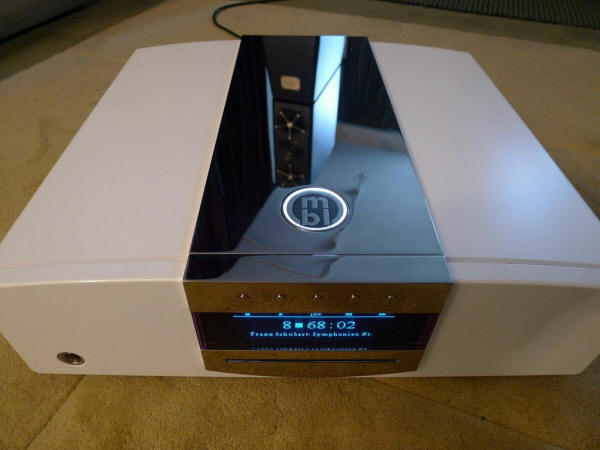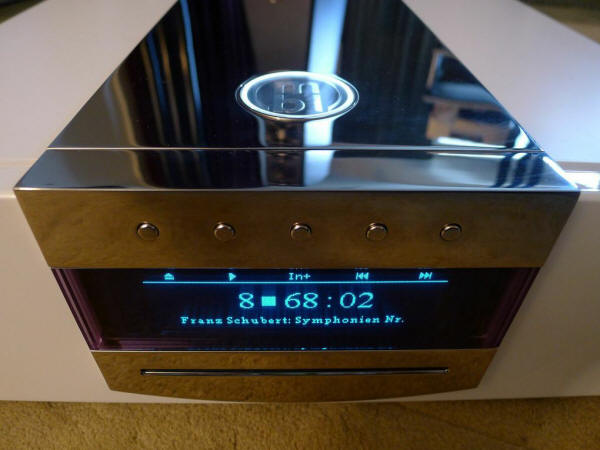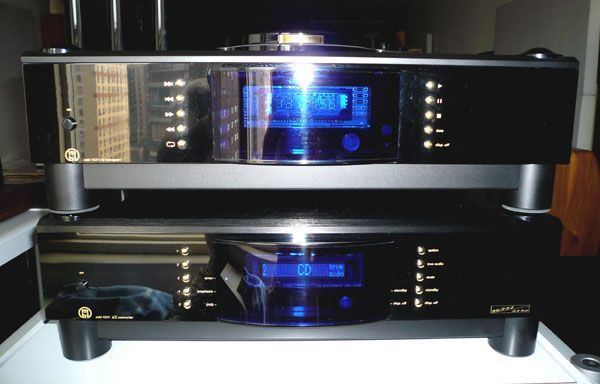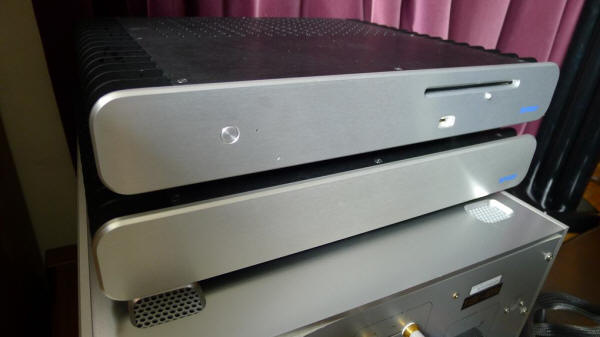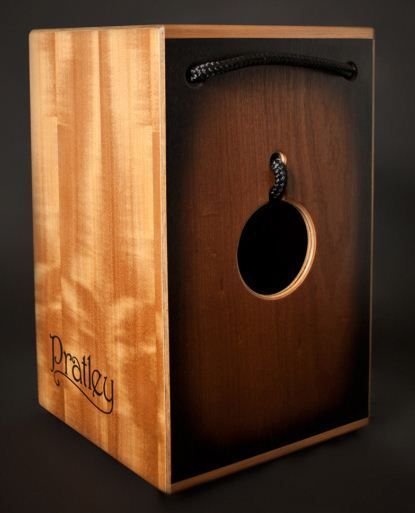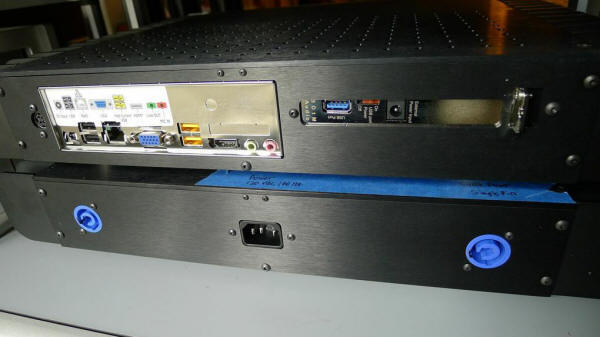|
You are reading the older HTML site
Positive Feedback ISSUE 67
My First Foray into Music Servers:
the mbl CD Player C31 & Sonore Signature Music Server
I'm happy to reside in the 20th century regarding audio. For someone who doesn't go with the herd, the Luddite philosophy has its attractions. Seriously, the fact of the matter is, I've yet to hear a server-based front-end that's as good as a first-rate one-box CD/SACD player. But Jeremy Bryan, chief honcho at mbl North America, Inc., the new North America distributor, was on a mission—to bring this reluctant reviewer into the 21st century. Jeremy was persuasive (and he's usually onto something). I had only one condition: he couldn't get annoyed at my frequent emails and phone calls with basic questions. I needed a guide to walk me through server setup, terminology, etc. He arranged delivery of his favorite, the Sonore Signature Music Server (MSRP $2499) and Signature Power Supply ($2199). Sonore is a boutique hi-fi component manufacturer based in Miami Lakes, Florida, which specializes in digital gear.
The new mbl Corona CD Player C31 ($9200) came along because it accepts up to 24-bit 96kHz Lpcm data on TosLink, S/PDIF, and asynchronous USB "natively." My Accuphase DP-600 does not support these inputs.
C31 Digital Inputs The first part of this article is a brief overview of what the Corona Player sounds like. Part 2 describes the Sonore server feeding the Corona DAC. Part 1: the Corona CD Player C31 "Now, this is nice" was Jonathan's first take on the player. By the third CD of the session he repeated it three times. High praise, indeed, coming from this died-in-the-wool analog devotee. "Hey, that violin sounds good." Now it was my turn. In my book, the violin is the challenge for digital. How a component handles it is a dead giveaway—most don't pass muster. After a while, it dawned on me: it's not just string instruments—I was enjoying singers, piano… all sound good, CD after CD.
That's probably the biggest difference between the Corona and the midline mbl Noble digital separates, which I owned until recently and costs more than twice the price—ease of listening. The new entry-level Corona sits more comfortably on the ear. the mbl House Sound is Intact The C31's ingratiating voice is attributable to a combination of factors. Although speed is good, transients have a rounded edge, and decay trails have ample pockets of air and tend to linger. The C31 sounds BIG: stage width is excellent, depth is good, and somehow height is enhanced. Image portraits are painted with a broad brush, over-sized, full-bodied and tall. They have fluid borders that sometimes overlap, which lends the stage a holistic quality. It is also powerful. I have to say, the low-end has a real punch and dynamic range is shockingly good for a component at this price point (another mbl trait that always brings a smile). The overall quality is smooth, grain and artifact free, and a tad warm. Plus let's not forget that solid, weighty foundation underpinning everything. Nothing about this presentation will jar you; there are no runaway treble projectiles, no low-frequency booms that excite the room uncontrollably. At all volume levels, the C31 is easy on the ear and you will find it non-fatiguing. All of these factors yield high coherency. So far this description fits the house sound to a tee.
mbl Noble separates Compared with the midline mbl Noble Separates The C31 has the latest digital circuits and innovations, including a newer DAC with improved specs. Is it better than the Noble Line 1511 DAC/1521 Transport separates? The numbers on paper say yes, I can't confirm that's what I'm hearing. As far as control and resolution, I'd have to say negative. Those fluid image borders mean instruments sometimes overlap; I don't recall that with the Noble gear. In terms of soundstaging, although the stage is wide, center images are more solid and I think the Noble may have better layered depth. (These are all related to the C31's holistic, blended sound.) Cosmetics and Ancillary Gear The Corona Line is styled differently than other mbl products. One or two visitors thought it had a '50s retro look. During most of the audition, my ancillary gear was the Luxman C-800f preamp and M-800A monoblocks. Towards the end, I switched to the mbl 6010D preamp—the C31 appreciated the swap and performance improved. There is a definite family synergy. I used a Kubala-Sosna Elation! single-ended interconnect and power cord most of the time. The Dynamic Design Nebula power cord was also a good choice, enhancing the Corona's clarity and control. Late in the audition, the Stage III Kraken power cord came in and did some amazing things. (Watch for an upcoming Stage III Kraken review.)
Sonore's top-of-the-line Signature Products come in matching sleek, expensive-looking, CNC-machined aluminum chassis. You can stack them. Features incorporated in the designs include a bunch of impressive sounding acronyms whose meaning I can't even guess at. Things like SATA filters made by SOtM; a dedicated TCIe USB card instead of the motherboard, also made by SOtM; onboard Digital Living Network Alliance (DLNA) and Digital Audio Access Protocol (DAAP) servers. If you're interested, go to the Sonore website to learn more. The Signature Power Supply contains two power supplies: a switching power supply for the motherboard and a linear power supply to feed the SOtM USB PCIe audio card. These are two large chassis with but a single-purpose: to feed your DAC the purest possible bit stream. I hard-wired the Sonore to my router with a very long Ethernet cable and controlled it from my Apple iPad using MPaD, a free app download. Ripping CDs is easy: the Sonore comes with everything you need, including a front-loading drive and storage. (The amount of storage is specified at time of order. My sample had two terabytes.) When the Sonore rips it, it becomes a FLAC file, which is 16/44 and lossless. (FLAC is still compressed in other ways, but is as close as I could get to comparing apples to apples.) Lately, I've been spending time with Red Book CDs, simply because that's where most of my music lives. I take off the green eyeshades and just enjoy. Or maybe I leave the green eyeshades on and analyze the result, if it helps me understand what a product is doing.
The first disc I ripped was Viva Caruso, featuring the Joe Lovano Street Band, a rather good sounding Red Book CD (Blue Note 7243 5 35986). It features a chamber jazz group including woodwinds, playing ambitious, third-stream, arrangements of tunes made famous by Enrico Caruso. Corrective Lenses for your Ears Wow! Even though the bit stream had the same density, the difference via the server was shocking. What a soundscape! Every instrument was laid out with absolutely no ambiguity about location or who was doing the talking at any given time. Image borders and dimensional cues were preternaturally precise without being etched. The spaces between them had the deepest "black background" I've ever encountered, to such a degree that they seemed islands unto themselves. That was the biggest change: what you get with the server delivering the bit stream is a soundstage where everything is decoded. It's like putting corrective lenses on your ears.
Another example: Y los Piratas del Flamenco (Sunnyside SSC 1135). The jazz trumpeter Jerry Gonzalez might be familiar to you as the leader of the Fort Apache Band, a group with some big hits in the 1980s. Jerry's no longer in the Bronx. He's in Spain exploring his roots music, producing jazz infused with flamenco influences. The credits include flamenco guitar, trumpet, cajón (a wooden, box-shaped percussion instrument, which the musician sits on and plays by slapping the front face with the hands) and palmas (hand clapping).
a contemporary cajón Listening through the C31 alone, it's obvious Jerry's overdubbing trumpet tracks on Monk's Soniquete ("Monk's Dream"). But how many are there? It's hard to say.
The first reaction upon switching to the Sonore was, "There's a lot more going on. You can figure out exactly what's happening." The server made it abundantly clear that this was not a minimally miked or audiophile-grade recording. Images are pinpoint, alright, but it's as if the engineer used a paint ball gun and splat them onto a 2-D screen. The stage is a hodge-podge and where they wound up seems random, location-wise. None of these guys seem to be relating to each other. Now the palmas POP like palms slapping together should, rather than being cupped. Transients are sharper and decay has truncated—the cajón makes deep bass sounds with a discernible transient followed by a sustain tone. Frequency balance is evenly spread and less midrangy, while tone is saturated, with scads of flesh and body. It's clear there are three overdubbed trumpets in Monk's Soniquete. Is it FLAT (FLAC) or WAVE (WAV)? (Pun Intended) It goes without saying, you want the server to deliver the purest data stream possible—that's what you get with the Sonore/C31 combo. The 20/20 acuity brought the skeletal and muscle structure of the musicians into view. And this auditory acuity came with an absence of artifacts—no harshness, grain or grit. Hence, it does not seem artificial. So far, all for the good. But notice that I didn't mention "flesh and blood" above and didn't talk about timbre. That's because the server had a thinner overtone umbrella and a slightly chilly aspect. The presentation avoids trespassing into analytical dryness—it still has plenty of spin on it—but it was wanting the ebb and flow, the heart and soul, of real performance. (Note: I didn't observe this problem with the mbl player alone, but it's possible the C31's relative soft focus might have masked it.) At this point, in spite of the servers' soundstaging prowess, most listeners preferred the CD, finding its images richer and more palpable. Wires Now it's time to talk about USB wires. My server came with a Cardas Clear USB cable ($134). This was quickly sidelined for an Audioquest Silver ($549). Later I got to try the Wireworld Platinum Starlight ($460). Both of these offered improvements. But nothing was like the legendary, discontinued Locus Design Cynosure V2 (last MSRP was $4200 1.5/m, I think), which brought a tremendous degree of warmth and humanity—exactly the commodities that were missing. Server/mbl DAC with 24/96 The big question is what happens when you serve up a file that's 24/96 (the mbl player's limit)? The server could sound phenomenal when fed a high-quality, hi-res file, such as Wagner Preludes And Overtures (Pentatone PTC 5186 041). The Sonore/C31 with this source induced a state of audio bliss. It becomes holographic, Cinerama, hi-def. No doubt about the resolution; ditto for the dynamics. Remember I mentioned those "deep black pockets" between instruments? On this recording, soundstage width was both vast and seamless—there were no more holes. (Apparently, this is either in the recording or not.) And there was a leap in the continuity of the musical line: It was less choppy. Reservations about timbre were forgotten. Soundstaging cues were crystal clear and musicians were placed in better relationships on the stage (dependent on the source, again). Conclusions In the context of my limited experiments with the mbl Corona CD Player C31 and the Sonore Signature Music Server, the takeaway is clear. First, the presentation of the two front-ends differs dramatically. The music server brought exceptional soundstage focus and clarity. For Red Book ripped to FLAC, these positives were offset by one noted drawback, i.e., a reduction in the complexity of the reproduction. A majority of listeners preferred the one-box mbl Corona C31CD Player. However, the scales tip dramatically when you introduce a hi-res source. Then it's a no-brainer: the music server outperforms decisively on all fronts. It simply takes you closer to the musical truth.
mbl
Akustikgeräte GmbH US distributor
mbl
North America, Inc
Sonore
by Simple Design, LLC
|

